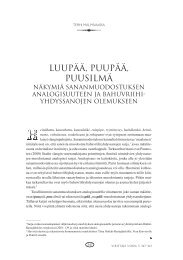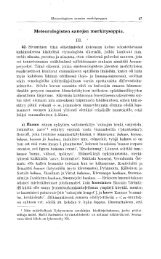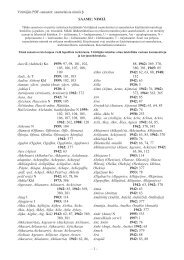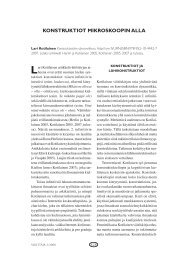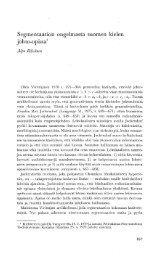pdf-tiedostona - Kotikielen Seura
pdf-tiedostona - Kotikielen Seura
pdf-tiedostona - Kotikielen Seura
Create successful ePaper yourself
Turn your PDF publications into a flip-book with our unique Google optimized e-Paper software.
Ergativity in Finnish<br />
Terho Itkonen<br />
II<br />
2.0. The opposition of agentivity and<br />
non-agentivity was evidenced to a greater<br />
or lesser degree in all five of the Finnish<br />
»ergative» phenomena which were treated<br />
from the synchronic aspect in the foregoing<br />
part of this article. This opposition<br />
must have its origin in elementary human<br />
cognitive tendencies; comp. Anderson's<br />
(1968, 1971) basic semantic cases ergative<br />
and nominative, distinguished by him primarily<br />
on the basis of English material.<br />
In the surface structure of English this<br />
opposition is admittedly not very clearly<br />
expressed. More illustrative are those systems<br />
of different languages in which it<br />
attempts to be manifested in the surface<br />
structure as well. The problem which a<br />
purely synchronic description avoids is<br />
nevertheless the well known »wie es<br />
eigentlich geworden ist ?»<br />
2.1. Let us return to the examples<br />
treated in the first part of this article.<br />
The sentence S. joutui hallitsevien piirien<br />
epasuosioon ja karkotettiin maasta 'S. fell<br />
into disfavour with the ruling circles and<br />
was expelled from the country' was regarded<br />
as representative of normal usage;<br />
the sentence S. julkaisi vield kolme teosta<br />
mutta karkotettiin sitten maasta 'S. published<br />
three more works but was then expelled<br />
from the country' does not give the<br />
impression of being equally natural. The<br />
naturalness of the first sentence can be<br />
accounted for in terms of the cognitive<br />
tendency; notice the two mutually compatible<br />
roles of S.: the non-agentive subject<br />
of an intransitive sentence + the<br />
non-agentive object of a transitive passive<br />
sentence. But do speakers create such<br />
combinations one at a time on the basis<br />
of that tendency, or have they always<br />
been so general that new occurrences of<br />
them can be regarded as manifestations<br />
of sentence patterns constituting a part<br />
of the competence of the speech com<br />
(Continuation of the article begun in 1974:4.)<br />
munity? The question may remain<br />
without a final answer. The latter example<br />
resembles the former one but it is felt<br />
to be unnatural because of zeugma:<br />
agentive S. + non-agentive S. It is<br />
possible that a speaker with a good sense<br />
for semantic finesses avoids sentences of<br />
this type without any tradition or control<br />
from the speech community to guide him.<br />
2.2. A non-agentive intransitive subject<br />
also appeared to be treated in the same<br />
manner as would be an object in the<br />
sentences Ovi aukeni avaimella 'the door<br />
opened with a key' and Ovi aukeni nappia<br />
painamalla 'the door opened by pressing<br />
a button'. In these sentences the instrumental<br />
adessive does not refer to the<br />
subject. The fact that sentences of this<br />
type are tolerated is an indication of that<br />
cognitive tendency, but again one is faced<br />
with the question of whether it exerts its<br />
influence in speakers separately every<br />
time, with no regard for what they<br />
have heard previously. This seems dubious;<br />
rather it might well be a question<br />
of a pattern which has come into being<br />
as a result of that cognitive tendency and<br />
then continued its life supported both by<br />
this tendency and by model sentences<br />
heard by the speakers. The position of<br />
this sentence type is nevertheless continuously<br />
unstable to a certain degree:<br />
it is threatened by the productive type<br />
Mies padsi sisaan avaimella ~ nappia painamalla<br />
'the man got in with a key ~<br />
by pressing a button' in which the instrumental<br />
adessive refers to an intransitive<br />
subject. This interpretation is in conflict<br />
with interpretation of the type Ovi aukeni<br />
avaimella — nappia painamalla 'the door<br />
opened by key ~ by pressing a button'<br />
and it may also be the cause of a certain<br />
degree of unconscious tension between<br />
the two different interpretations.<br />
2.3. The subject of the sentence type<br />
(Han on) valveilla '(he is) awake', (Talo<br />
on) rakenteilla '(the house is) a-building'<br />
57



